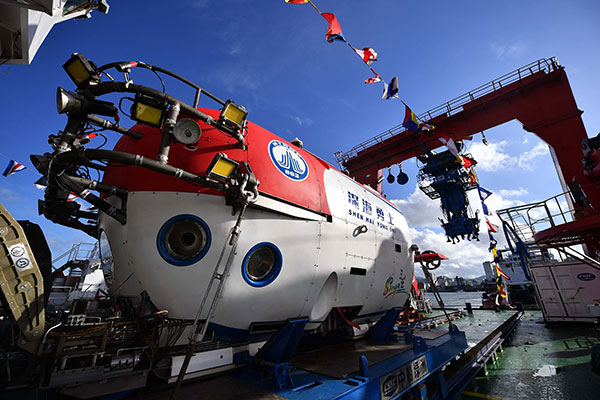 China's new manned submersible, Shenhai Yongshi, on board the exploration ship Tansuo-1, returns to port on Tuesday in Sanya, Hainan province, after completing deep-sea testing in which it reached a depth of 4,500 meters. (GUO CHENG/XINHUA) China's new manned submersible returned to port in Sanya, Hainan province, on Tuesday after completing its first deep-sea testing in the South China Sea. The new submersible is called Shenhai Yongshi, meaning deep-sea warrior. It reached a depth of 4,500 meters during tests while on a 50-day expedition trip on board the science exploration ship Tansuo-1. "It is another great achievement for China in developing deep-sea manned submersibles," said Bai Chunli, president of the Chinese Academy of Sciences, in a congratulatory letter. "The submersible can be classified as one of the most advanced in the world," he said in the letter. "This means China has become a nation capable of producing and testing its own massive deep-sea submersibles." Other countries that have developed deep-water technology include the United States, France, Russia and Japan. Bai said the new submersible will be available for public research, and become "another key instrument in our nation's deep-sea exploration." In 2002, China began its first deep-sea manned submersible project. In 2010, the Jiaolong, named after a mythical sea dragon, went into service. In June 2012, it completed its deepest dive, reaching 7,062 meters in the Mariana Trench. The new vessel builds on Jiaolong's success, and is more optimized and cost-efficient, Ye Cong, the new submersible's deputy chief designer, said in August. While much of Jiaolong's equipment was imported, around 90 percent of the deep-sea warrior and all of its core components were domestically made, according to the Ministry of Science and Technology. The new device also has five observation windows-two more than Jiaolong, Ye said. It is also equipped with highly efficient lithium batteries instead of the traditional silver-zinc ones, which can be used 500 times instead of just 50, reducing the cost of each dive, he added. Hu Zhen, the chief designer of the new submersible, said many extractable resources, as well as key research subjects such as underwater vents, are located around 3,000 meters beneath the surface. Hence a 4,500-meter submersible is enough to explore most of China's waters, including all of the South China Sea. At the same time, China is aiming to reach the 10,000-meter depth someday, so the deep-sea warrior can serve as a foundation to train future talent and build new, domestically made submersibles capable of deeper depths, he added. |
Powered by Discuz! X3.4
© 2001-2013 Comsenz Inc.